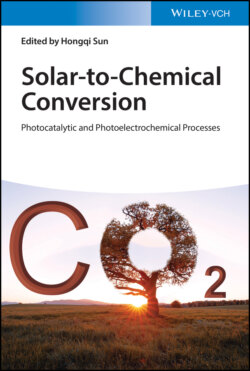Читать книгу Solar-to-Chemical Conversion - Группа авторов - Страница 26
2.5 Perspective
ОглавлениеThe energy shortage and environmental‐related problems are becoming the worsening global crisis and the great challenges for human in the twenty‐first century. The artificial photosynthesis process involved in transformation of carbon dioxide and water to value‐added chemical fuels is a promising strategy to rebuild the global energy consumption and elemental balance, and the potential rewards are enormous. Up to now, the main goal of scientists is to synthesize photoactive materials that are able to chemically couple these light‐driven redox reactions together and to achieve conversion efficiency and selectivity that outperforms nature's photosynthesis. However, photoconversion of carbon dioxide with water contains thermodynamically uphill, multi‐electron, multi‐hole, and multi‐proton processes occurring on a multicomponent photocatalyst, where many challenges are presented in the fields of catalysis, energy science, semiconductor physics, and engineering. To develop effective artificial photosynthesis and conversion, several key considerations must be balanced, including the following: (i) A deep understanding of processes that occur on the surface of photocatalysts during artificial photosynthesis processes, e.g. adsorption/desorption of gaseous reactants, products, and intermediates, as well as the role of adsorbed water. (ii) The potential great improvement of efficiency in carbon dioxide photoreduction can result from significantly increasing the lifetime of the charge‐separated state. The time scale of this electron–hole recombination is two to 3 orders of magnitude faster than other electron transfer processes. Therefore, any process that inhibits electron–hole recombination would greatly increase the efficiency and rates of carbon dioxide reduction and water oxidation. For example, electrical conductivity and diffusion length of the photocatalyst should be as high as possible to minimize recombination of electron–hole pairs. Ultrathin nanostructures may also facilitate the charge carrier transport to surface reaction sites to participate reductive chemistry. Spatial separation of photoexcited electrons and holes can also be reduced by the electron–hole recombination, which was achieved by cocatalysts, Z‐scheme, or heterostructures of coupling two semiconductors with properly aligned band structures. (iii) The kinetics of photocatalytic carbon dioxide reduction is also dependent upon light absorption by the photocatalyst. Many optical techniques are potentially useful for harvesting light for improvement of the efficiency including structuring for multiple light scattering to increase the effective optical path length, and upconversion to transform non‐absorbed infrared light to absorbed visible light. (iv) Large surface area and porosity are required to maximize the adsorption, transport, and desorption of reactants, intermediates, and products. (v) As defects such as oxygen vacancies control most of the chemistry at many metal oxide surfaces, oxygen vacancies are believed to act as a very important role on electron trapping and activating CO2. The oxygen vacancies can be created either by doping with other anions or cations or by thermal treatments of stoichiometric photocatalysts, and these defects can be detected with in situ electron paramagnetic resonance spectroscopy, UV photoemission spectroscopy, metastable impact electron spectroscopy, and so on. (vi) A high‐efficiency process is also necessary to be founded on photoactive materials made of earth‐abundant, nontoxic, light‐stable, scalable, and low‐cost materials.
In addition, the efficiency of photocatalytic reduction of carbon dioxide could be deactivated after irradiation for long time. The deactivating phenomenon in the photocatalytic reduction of carbon dioxide can be attributed to the following three reasons: (i) The adsorption or accumulation of intermediate products on the semiconductor surface could occupy photocatalytic reaction centers and also hinder the adsorption of carbon dioxide or water, which could lead to the deactivation of semiconductors under the continuous irradiation. (ii) The desorption of hydrocarbon production affects the continuous adsorption of reactants that take part in the photocatalytic reaction. (iii) The surface contamination of semiconductors shields the light absorption, resulting in the reduction of the generation of electron–hole pairs. Therefore, it is necessary to pay more attention to the study of semiconductor deactivation in future work.
